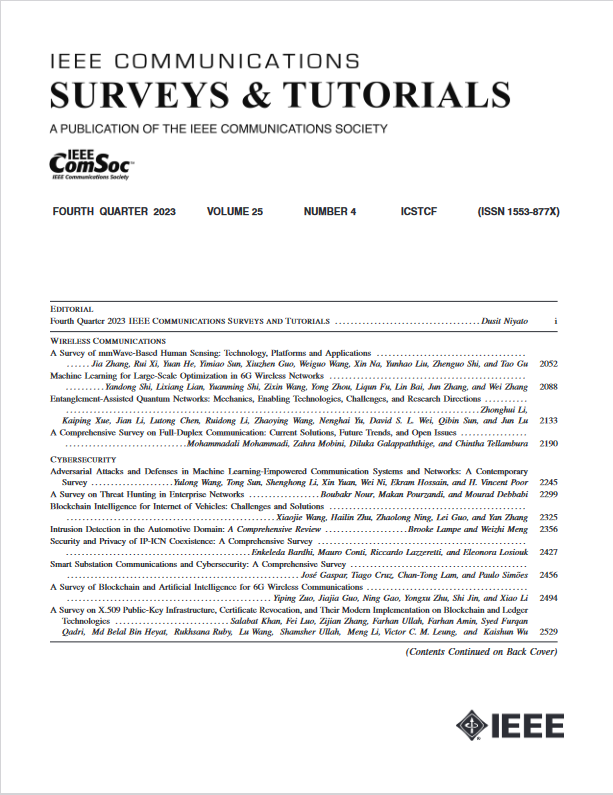面向 6G 的超大规模 MIMO 教程:基础、信号处理和应用
IF 34.4
1区 计算机科学
Q1 COMPUTER SCIENCE, INFORMATION SYSTEMS
引用次数: 0
摘要
超大规模多输入多输出(XL-MIMO)可提供巨大的空间自由度,已成为第六代(6G)无线移动网络潜在的关键使能技术。随着其重要性的与日俱增,机遇与挑战并存。本文全面介绍了 XL-MIMO 无线系统的研究情况。我们特别介绍了四种 XL-MIMO 硬件架构:基于均匀线性阵列 (ULA) 的 XL-MIMO、基于均匀平面阵列 (UPA) 的 XL-MIMO (利用贴片天线或点阵天线)和基于连续孔径 (CAP) 的 XL-MIMO。我们全面分析和讨论了它们的特点和相互关系。随后,我们介绍了 XL-MIMO 的几种电磁特性和一般距离界限。鉴于近场通信的独特电磁特性,我们提出了一系列信道模型,以展示 XL-MIMO 的优势。我们进一步讨论并总结了 XL-MIMO 的信号处理方案。值得注意的是,我们回顾并强调了低复杂度信号处理方案和深度学习信号处理方案,以促进 XL-MIMO 的实际应用。此外,我们还探讨了 XL-MIMO 与其他新兴 6G 技术之间的相互作用。最后,我们概述了未来 XL-MIMO 无线通信系统的几个引人注目的研究方向。本文章由计算机程序翻译,如有差异,请以英文原文为准。
A Tutorial on Extremely Large-Scale MIMO for 6G: Fundamentals, Signal Processing, and Applications
Extremely large-scale multiple-input-multiple-output (XL-MIMO), which offers vast spatial degrees of freedom, has emerged as a potentially pivotal enabling technology for the sixth generation (6G) of wireless mobile networks. With its growing significance, both opportunities and challenges are concurrently manifesting. This paper presents a comprehensive survey of research on XL-MIMO wireless systems. In particular, we introduce four XL-MIMO hardware architectures: uniform linear array (ULA)-based XL-MIMO, uniform planar array (UPA)-based XL-MIMO utilizing either patch antennas or point antennas, and continuous aperture (CAP)-based XL-MIMO. We comprehensively analyze and discuss their characteristics and interrelationships. Following this, we introduce several electromagnetic characteristics and general distance boundaries in XL-MIMO. Given the distinct electromagnetic properties of near-field communications, we present a range of channel models to demonstrate the benefits of XL-MIMO. We further discuss and summarize signal processing schemes for XL-MIMO. It is worth noting that the low-complexity signal processing schemes and deep learning empowered signal processing schemes are reviewed and highlighted to promote the practical implementation of XL-MIMO. Furthermore, we explore the interplay between XL-MIMO and other emergent 6G technologies. Finally, we outline several compelling research directions for future XL-MIMO wireless communication systems.
求助全文
通过发布文献求助,成功后即可免费获取论文全文。
去求助
来源期刊

IEEE Communications Surveys and Tutorials
COMPUTER SCIENCE, INFORMATION SYSTEMS-TELECOMMUNICATIONS
CiteScore
80.20
自引率
2.50%
发文量
84
审稿时长
6 months
期刊介绍:
IEEE Communications Surveys & Tutorials is an online journal published by the IEEE Communications Society for tutorials and surveys covering all aspects of the communications field. Telecommunications technology is progressing at a rapid pace, and the IEEE Communications Society is committed to providing researchers and other professionals the information and tools to stay abreast. IEEE Communications Surveys and Tutorials focuses on integrating and adding understanding to the existing literature on communications, putting results in context. Whether searching for in-depth information about a familiar area or an introduction into a new area, IEEE Communications Surveys & Tutorials aims to be the premier source of peer-reviewed, comprehensive tutorials and surveys, and pointers to further sources. IEEE Communications Surveys & Tutorials publishes only articles exclusively written for IEEE Communications Surveys & Tutorials and go through a rigorous review process before their publication in the quarterly issues.
A tutorial article in the IEEE Communications Surveys & Tutorials should be designed to help the reader to become familiar with and learn something specific about a chosen topic. In contrast, the term survey, as applied here, is defined to mean a survey of the literature. A survey article in IEEE Communications Surveys & Tutorials should provide a comprehensive review of developments in a selected area, covering its development from its inception to its current state and beyond, and illustrating its development through liberal citations from the literature. Both tutorials and surveys should be tutorial in nature and should be written in a style comprehensible to readers outside the specialty of the article.
 求助内容:
求助内容: 应助结果提醒方式:
应助结果提醒方式:


